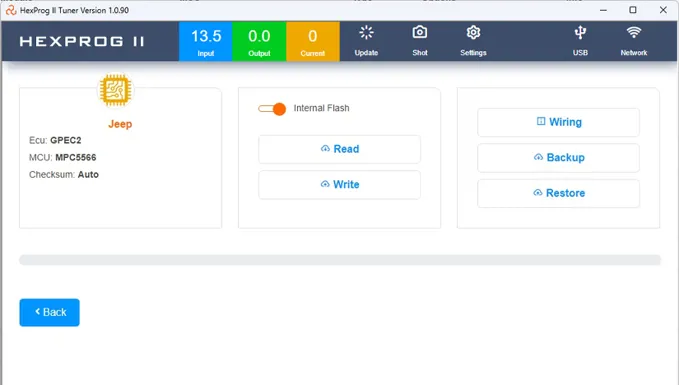Fiat Group "FCA" currently produces vehicles under twelve brands: Abarth, Alfa Romeo, Chrysler, Dodge, Ferrari, Fiat, Fiat Professional, Jeep, Lancia, Maserati, Ram Trucks, and SRT.
The GPEC2 found in Chrysler, Dodge, Fiat, Jeep is indeed a sophisticated Engine Control Unit (ECU) that plays a pivotal role in the operation and performance of various vehicles. Its intricate design and unique features pose challenges and opportunities for technicians engaged in ECU Repair and ECU Programming.
This ECU, specific to Jeep, presents a challenging task due to its unique characteristics. The only viable mode for interaction is the boot mode, which requires the ECU to be opened for data read and write operations. Cloning this ECU is achievable through the backup and restore functionalities, and without IMMO present in the OTP section of the ECU, cloning is made effortless and successful.
ECU Cloning is a meticulous process that involves creating an exact duplicate of the original ECU. This task is particularly important when replacing a faulty ECU with a new one, ensuring that the replacement unit behaves identically to the original. The ability to perform ECU Cloning on the GPEC2 highlights its adaptability and responsiveness to advanced diagnostic and repair techniques. On the other hand, ECU Repair involves diagnosing and resolving issues that may affect the GPEC2's circuitry, components, and ECU files. Given the complexity of the GPEC2, technicians need to possess in-depth knowledge of its internal workings and have access to specialized tools and equipment. The physical opening of the ECU in Boot Mode allows for a thorough examination and targeted repairs, contributing to the longevity and optimal performance of the vehicle.
Limited accessibility through Boot Mode poses a significant hurdle for automotive technicians and engineers in diagnosing, repairing, and modifying this ECU. However, professionals with extensive knowledge and expertise can adeptly navigate this intricate process, proficiently performing both ECU cloning and repair procedures.
Concurrently, ECU repair remains a critical facet in addressing the challenges posed by this complex ECU. Given its intricate nature, the ECU may encounter occasional hardware or software issues, resulting in disruptions to the vehicle's performance. Competent technicians specializing in ECU repair possess the skills to meticulously diagnose these issues, pinpoint faulty components, and execute the requisite repairs, ultimately restoring the ECU's optimal functionality.
In addition to contending with the challenges presented by restricted accessibility, the process of modifying the Engine Control Unit (ECU) demands a meticulous approach. Even seemingly minor alterations to the ECU's programming can exert profound effects on the vehicle's performance, emissions, and overall safety. Consequently, it is imperative for professionals to exercise utmost caution and expertise when engaging in ECU modifications aimed at achieving specific performance enhancements or customizations. These modifications must align with pertinent regulations to safeguard compliance and avoid compromising the vehicle's reliability.
In summary, the substantial challenge posed by limited accessibility in Boot Mode underscores the complexity faced by automotive technicians and engineers in the realm of ECU diagnostics, repairs, and modifications. Despite this hurdle, the adeptness and know-how of skilled professionals equip them to adeptly navigate these intricacies. Their capabilities extend to executing tasks such as ECU Cloning, ECU Repairs, and ECU modifications with precision and efficiency, thereby playing a pivotal role in ensuring the smooth operation and reliability of contemporary vehicles.
To accomplish the intricate task of cloning and repairing this challenging ECU, automotive professionals rely on dedicated ECU Programming Tools and software. One widely acclaimed solution for this purpose is hardware, seamlessly paired with Hexprog II Tuner software. Engineered with precision, Hexprog II is tailored to interface with hard-to-reach GPEC2 ECUs, as commonly encountered in select Fiat Chrysler group. This integrated hardware and software system empowers technicians to seamlessly read, write, and repair the ECU's data, facilitating efficient modification for desired changes.
Below are the steps for cloning GPEC2 ECU:
- Preparation: Before starting the cloning process, ensure you have the necessary tools and equipment. You'll need Hexprog II hardware and Hexprog II Tuner software with valid cloning and ECU license. You must use Hexprog II Tuner software to check the wiring diagram of the GPEC2 ECU, and arrange soldering equipment and stay wires as necessary.
- Accessing Boot Mode: Since this GPEC2 ECU can only be accessed through Boot Mode, the first step is to open the ECU and establish a connection to its internal circuitry along with external connections. This is usually done using specialized tools and boot and signal wires given with Hexprog II, and it requires a delicate touch to avoid damaging any components.
- Reading Original ECU Data: Once the connection to the ECU is established, Hexprog II hardware, combined with Hexprog II Tuner software, is used to read and extract the data from the original ECU. It is possible to read internal flash separately in .bin format that can be used for modification and Chip tuning. This data contains essential information about the vehicle's settings, calibration, and configurations
- Creating a Backup: The user needs to use the backup button to back up the whole ECU data. After successfully reading the data from the original ECU, backup files are created. This backup file contains all the information required to clone the ECU accurately. It is essential to store these backup files safely as it serves as the foundation for the cloning process.
- Preparing the New ECU: If the goal is to clone the ECU onto a new or refurbished one, the new ECU must be prepared. This involves ensuring that the new ECU is compatible with the vehicle and in working condition.
- Restoring Data onto New ECU: With the new ECU prepared, the next step is to use Hexprog II hardware and Hexprog Tuner software to restore the original backup file onto the new ECU. This process transfers all the original settings and configurations to the new ECU, effectively creating an identical copy of the original. Before restoring the original data we recommend users to make a backup of new or donor ECU for safety concerns in the future.
- Testing and Verification: After the cloning process is complete, it's essential to verify the functionality of the newly cloned ECU. The vehicle should be tested to ensure that all systems are working correctly and that there are no error codes or malfunctions.
- Finalization: Once the cloned ECU is verified to be functioning properly, the ECU can be securely reinstalled in the vehicle. It is crucial to ensure that all connections are secure, and the ECU is properly seated.
It is crucial to emphasize that both ECU Cloning and ECU Repair should exclusively be conducted by highly trained professionals or skilled technicians possessing a comprehensive understanding of the intricate process. The stakes are high, as any errors or oversights during cloning or repair may lead to severe consequences affecting the vehicle's performance and security.
The procedures involved in ECU Cloning and ECU Repair are inherently complex and demanding. However, they provide indispensable solutions for preserving the functionality of vehicles equipped with challenging ECUs. These processes empower automotive specialists to deliver effective solutions to their customers, ensuring that their vehicles continue to operate optimally and reliably.
As the automotive industry progresses, witnessing a continuous evolution in vehicle technology, the expertise in ECU Cloning and ECU Repair becomes increasingly pivotal in the maintenance and repair of modern vehicles. Each passing year sees automotive manufacturers integrating more sophisticated electronic control units (ECUs) into their vehicles. These ECUs are responsible for managing various functions and systems within the automobile.
OTHER SERVICES SUPPORTED
In the realm of automotive performance and tuning, diversifying methods for modifying the Engine Control Unit (ECU) extend beyond mere cloning. An alternative technique in ECU Repair involves delving into the intricacies of the internal flash of the ECU and effecting adjustments to the file, enabling specific modifications. The pivotal role of ECUs in modern vehicles lies in their control and management of various engine parameters, ensuring not only optimal performance but also fuel efficiency and compliance with emission standards. Despite these critical functions, automotive enthusiasts and tuners frequently aspire to unlock the full potential of their vehicles. This pursuit involves tailoring the ECU's settings to align with distinct driving preferences or targeted performance objectives.
This advanced level of customization extends beyond conventional tuning methods, offering tuners the precision needed to optimize engine performance according to their exact specifications. Reading and decoding the hexadecimal data from the ECU's internal flash allows for a granular understanding of the intricate processes governing the engine.
By strategically manipulating this code, skilled tuners can implement changes that go beyond the capabilities of standard ECU Cloning. Disabling DTC becomes a meticulously tailored process, allowing for a more nuanced and targeted approach to performance enhancement. This level of control enables automotive enthusiasts to fine-tune their vehicles to match specific driving preferences or meet ambitious performance goals.
In essence, while ECU Tuning provides a foundation for modification, the direct access to the ECU's internal flash memory opens up a realm of possibilities for those seeking a truly bespoke and optimized driving experience. This intricate method reflects the artistry and technical prowess of tuners dedicated to pushing the boundaries of automotive performance customization.
Furthermore, our exclusive online service is designed to simplify functions like DTC Removal. Users can conveniently access this service through their accounts on www.hexprog.com. Additionally, Stage Performance Tuning for this ECU can be seamlessly achieved using third-party software. When a file undergoes modifications, it seamlessly integrates back into the system with Hexprog II Tuner's auto checksum feature, guaranteeing data integrity and precision. Furthermore, our advanced Hexprog II Tuner software effortlessly writes any modifications made to the internal flash back into the system with checksum correction. This cutting-edge process ensures that the modified data remains secure and error-free throughout the entire operation.
For handling internal flash tasks, Hexprog II Tuner software stands out as the ideal tool. With features like checksum correction, version control, and real-time data monitoring, users have a comprehensive set of tools at their disposal. This empowers users to confidently apply changes, secure in the knowledge that the system will maintain its stability and reliability throughout the process.
With our cutting-edge suite of online services and robust software solutions, customers gain the seamless ability to proficiently manage, customize, and refine their systems with unwavering confidence and pinpoint precision. Whether it involves checksum verification, dynamic flash programming, or any other facet of online support, our platform is meticulously crafted to provide not just satisfactory, but exceptional performance, ensuring unparalleled results for our valued users.
More Info about GPEC2
Hexprog II is a specialized ECU chip tuning tool that can read and write all contents of the GPEC2 ECU Boot mode. For more detailed information about the GPEC2 and the capabilities of Hexprog II tool, you can refer to the following links:
Hexprog II GPEC2 Details: Chrysler GPEC2 , Dodge GPEC2, Fiat GPEC2, Jeep GPEC2
Hexprog II product page: HEXPROG II ECU CHIP TUNING TOOL
Hexprog II ordering page: Hexprog II Order
Please visit the provided links to learn more about the GPEC2 ECU and Hexprog II tool for ECU chip tuning




